User Manual
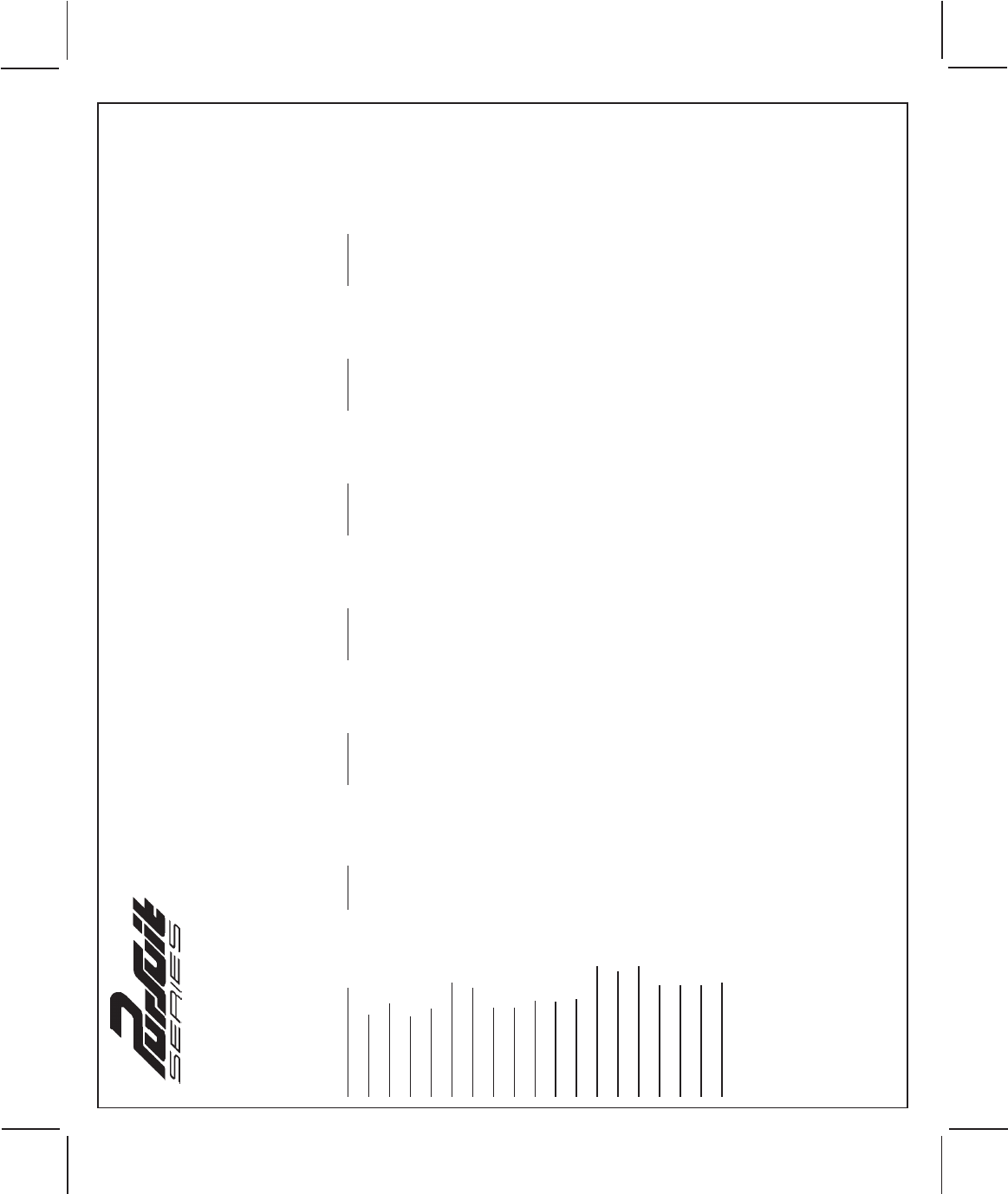
128-8857
1 of 20
The selectable features can be set manually as explained below, or with the RF feature programmer.
To set features using the RF programmer, follow the instructions packaged with the programmer.
Factory default settings are indicated by bold text.
Note: The manual override method can be selected to either operate from the valet switch or operate as custom code.
Note: Keyless Entry Models with no horn output will Flash the Parking Lights instead of chirp where chirp is indicated.
Also, No data will be indicated if a feature is not available for a particular model. The unit will enter the feature but no selection will be available.
RF Programmable Feature Bank 1 Is For Transmitter Programming. See the Transmitter Programming Guide.
RF Programmable Features Bank 2 Is Alarm Selectable Features:
Feature Selection 1 Chirp 2 Chirps 3 Chirps 4 Chirps 5 Chirps 6 Chirps
1st DoorL/UL 1 Sec. 3.5 Sec. 1 Sec L, Dbl. U/L Dbl L, 1 Sec UL Dbl L, Dbl UL 1 S l/350mS ul
2nd Accy Lock Not Available
3rd Accy. UL Not Available
4th Headlights Not Available
5th Passive Locks Not Available
6th Pass/Act Arm Not Available
7th Siren/Horn Not Available
8th Horn Chirp Not Available
9th O/R Method Not Available
10th 2 Step U/L Not Available
11th Chp Del Tx Not Available
12th Voltage/Hd Wire Not Available
13th Trigger Circuits Not Available
14th Lock/Unlock Poll Not Available
15th Aux Ch 5 Sel Not Available
16th Aux Ch 6 Sel Not Available
17th Aux Ch 7 Sel Not Available
18th Trigger Delay Not Available
When using the RF programmer, enter the program mode as follows:
Turn the ignition on.
Press and release the valet switch 3 times.
Turn the ignition off then on.
Press and hold the valet switch for 5 seconds.
Siren and or lights chirp/flash 2 times indicating access to RF feature program mode.
Model PRO-9056TW
Installation Manual

128-8857
2 of 20
To program these selectable features;
Action System Response
Turn ignition on No response
Press and release the valet switch 3 times 1 Chirp - LED 1 flash
Within 3 seconds, turn ignition Off Then On Short chirp, then long chirp
This Action Accesses Feature Bank 2 Alarm Selectable Features
First Press and release the valet switch 1 time 1 chirp = 1 second door lock & unlock
Press transmitter Lock button to change 2 chirps = 3.5 second door lock & Unlock
Press transmitter Lock button to change 3 chirps = 1 sec. lock, dbl 1 sec. unlock
Press transmitter Lock button to change 4 chirps = dbl 1 sec lock, 1 sec unlock
Press transmitter Lock button to change 5 chirps = dbl 1 sec lock, dbl 1 sec unlock
Press transmitter Lock button to change 6 chirps = 350mS unlock. 1 sec lock
or
Second Press and release the valet switch Non Functional On This Unit
or
Third Press and release the valet switch Non Functional On This Unit
or
Fourth Press and release the valet switch Non Functional On This Unit
or
Fifth Press and release the valet switch Non Functional On This Unit
or
Sixth Press and release the valet switch Non Functional On This Unit
or
Seventh Press and release the valet switch Non Functional On This Unit
or
Eighth Press and release the valet switch Non Functional On This Unit
or
Ninth Press and release the valet switch Non Functional On This Unit
or
Tenth Press and release the valet switch Non Functional On This Unit
or
Eleventh Press and release the valet switch Non Functional On This Unit
or
Twelfth Press and release the valet switch Non Functional On This Unit
or
Thirteenth Press and release the valet switch Non Functional On This Unit
or
Fourteenth Press and release the valet switch Non Functional On This Unit
or
Fifteenth Press and release the valet switch Non Functional On This Unit
or
Sixteenth Press and release the valet switch Non Functional On This Unit
or
Seventeenth Press and release the valet switch Non Functional On This Unit
or
Eighteenth Press and release the valet switch Non Functional On This Unit
or
Press and release the valet switch or turn the ignition off to: Exit Programming Mode
or
Turn ignition switch off then on to advance to feature Bank 3:

128-8857
3 of 20
To exit program mode, turn ignition off, or press and release valet switch.
RF Programmable Features Bank 3 Is Remote Start Selectable Features:
Feature Selection 1 Chirp 2 Chirps 3 Chirps 4 Chirps 5 Chirps 6 Chirps
1st Defrost Output NA
2nd RF Start Chirp NA
3rd Run Time 5 Mins 10 Mins 15 Mins 20 Mins 45 Mins 60 Mins
4th Parking Lights On Steady Flashing
5th Input Check Voltage Tach DBI Tach Hybrid
6th Voltage Level >0.5V B4 Start < 0.5V B4 Start
7th Ign. 2 Select Off During Crank On During Crank Same As Accy.
8th Ign. 3 Select NA
9th Diagnostics Off On
10th Crank Time 0.8 Sec 1.0 Sec 1.5 Sec 2.0 Sec
11th Gas/Diesel Gas Diesel 10 Diesel 15 Diesel 20
12th Transponder O/P While R/S On During Start Until Ign. Off
13th Temp Start Not Available
14th Crank Averaging Averaging Preset Time
Note: When averaging, the engine must be started 4 times with the key to be effective.
15th R/S Shock NA
16th Turbo Select NA
17th Black/Blue (Aux O/P) Single Pulse As Feat #1 Bank 2
18th One or Two Press Start Two Press One Press
Note: When feature #5 is set for Voltage or Hybrid, the unit must also have feature #14 set for Preset Time or the unit will flash the Pk. Lts. 7 times and not
start.
Note: When setting feature #17 to operate as feature #1 Bank 1, the transmitter will also control this output only while running under R/S command. So in
other words, if this output is used to unlock the doors with the transmitter, the doors will unlock on startup. To relock the doors, use the After Start
Black Green wire of the 4 pin connector.
When using the RF programmer, enter the program mode as follows:
Turn the ignition on
Press and release valet switch 3 times
turn ignition off then on
Press and hold valet switch for 5 seconds
Siren chirps 2 times indicating access to RF feature program mode.
To exit program mode, turn ignition off, or press and release valet switch.

128-8857
4 of 20
Action System Response
Turn ignition on No response
Press and release the valet switch 3 times 1 Chirp - LED 1 flash
Within 3 seconds, turn ignition Off, On, Off, On Short chirp, then 2 long chirps
This Action Accesses Feature Bank 3 Remote Start Selectable Features
First Press the valet switch one time Non Functional On This Unit
or
Second Press and release the valet switch Non Functional On This Unit
or
Third Press and release the valet switch 2 chirps = run time set for 10 mins
Press transmitter Lock button to change 3 chirps = run time set for 15 mins
Press transmitter Lock button to change 4 chirps = run time set for 20 mins
Press transmitter Lock button to change 5 chirps = run time set for 45 mins
Press transmitter lock button to change 6 chirps = run time set for 60 mins
Press transmitter lock button to change 1 chirp = run time set for 5 mins
or
Fourth Press and release the valet switch 1 chirp = parking lights on steady w/RS active
Press transmitter Lock button to change 2 chirps = parking lights flashing w/RS active
or
Fifth Press and release the valet switch 2 chirps = tachometer input checking
Press transmitter Lock button to change 3 chirps = DBI Tach Mode
Press transmitter Lock button to change 4 chirps = Hybrid Mode
Press transmitter Lock button to change 1 chirp = voltage sense input checking
or
Sixth Press and release the valet switch 1 chirp = greater than 0.5 V check before start
Press transmitter Lock button to change 2 chirps = less than 0.5 V check before start
or
Seventh Press and release the valet switch 2 chirps = ign 2 on during crank
Press transmitter Lock button to change 3 chirps = ign 2 same as accessory
Press transmitter Lock button to change 1 chirp = ign 2 off during crank
or
Eighth Press and release the valet switch Non Functional On This Unit
or
Ninth Press and release the valet switch 1 chirp = diagnostics off
Press transmitter Lock button to change 2 chirps = diagnostics on
or
Tenth Press and release the valet switch 2 chirps = crank time 1.0 sec
Press transmitter Lock button to change 3 chirps = crank time 1.5 sec
Press transmitter Lock button to change 4 chirps = crank time 2.0 sec
Press transmitter Lock button to change 1 chirp = crank time 0.8 sec
or
Eleventh Press and release the valet switch 1 chirp = unit set for gasoline engine
Press transmitter Lock button to change 2 chirps = unit set for diesel engine 10 sec delay
Press transmitter Lock button to change 3 chirps = unit set for diesel engine 15 sec delay
Press transmitter Lock button to change 4 chirps = unit set for diesel engine 20 sec delay
or
Twelfth Press and release the valet switch 1 chirp = transponder output while R/S active
Press transmitter Lock button to change 2 chirps = transponder output during start only
Press transmitter Lock button to change 3 chirps = transponder output until ignition turned off
or
Thirteenth Press and release the valet switch Non Functional On This Unit
or
Fourteenth Press and release the valet switch 1 chirp = crank averaging w/voltage input checking
Press transmitter Lock button to change 2 chirps = preset crank time w/voltage input check
or
Fifteenth Press and release the valet switch Non Functional On This Unit
or
Sixteenth Press and release the valet switch Non Functional On This Unit
or
Seventeenth Press and release the valet switch 1 chirp = aux o/p Black/Blue single pulse
Press transmitter Lock button to change 2 chirps = aux o/p Black/Blue as alarm feature #1
or
Eighteenth Press and release the valet switch 1 chirp = double press to start
Press transmitter Lock button to change 2 chirps = single press to start
or
Turn the ignition off to: Exit Programming Mode
Note : Once you enter the feature programming mode, do not allow more than 15 seconds to pass between steps or the
programming will be terminated.

128-8857
5 of 20
This Remote Start System is designed for use with Automatic Transmission Vehicles Only! The unit provides
wait to start input for glow plug pre-heat which will be used for all diesel applications. If this wire is not connected,
then the unit will remain in the Gasoline mode setting, which will crank the car when the RF signal is received
with no delay. Regardless of the vehicle, Gasoline or Diesel, for every installation, the vehicle MUST HAVE a Tach
Signal Input and an Automatic Transmission.
INSTALLATION OF THE MAJOR COMPONENTS:
CONTROL MODULE:
Select a mounting location inside the passenger compartment (up behind the dashboard). The mounting location
selected must be within 24" of the ignition switch wiring harness to allow connection of the 6 pin main wiring
harness.
Be certain that the chosen location will not interfere with proper operation of the vehicle. Avoid mounting the module
to or routing the wiring around the steering shaft/column, as the module or wiring may wrap around or block the
steering wheel preventing proper control of the vehicle. Secure the module in the chosen location using cable ties
or screws as necessary.
Note: Do Not Mount The Module In The Engine Compartment, as it is not waterproof.
HOOD PIN SWITCH:
The pin switch included in this package is intended for protecting the hood area of the vehicle. In all cases,
the switch must be mounted to a grounded metal surface. When the pin switch is activated, (hood open), it
will supply a ground to the input wire activating the alarm. In addition, the hood switch is required for the
safety shut down of the remote start unit. If the vehicle is being worked on, this hood switch prevents the
remote start activation even if the RF command to start is issued. This switch must be installed in all
applications. Failure to do so may result in personal injury or property damage. Mount the switch in
a location away from water drain paths. If necessary, an optional bracket may be used to move the switch
away from rain gutters or allow mounting to the firewall behind the hood seal. In both cases the switch must
be set up to allow the hood to depress the switch at least 1/4 inch when the hood is closed and fully
extended when the hood is opened. For direct mounting, a 1/4 inch hole must be drilled. Carefully check
behind the chosen location to insure the drill will not penetrate any existing factory wiring or fluid lines.
Drill a 1/4" hole in the desired location and thread the pin switch into it using a 7/16" nut driver or deep well
socket. If using the mounting bracket, first secure the bracket to the desired location and secure the pin
switch in the pre-threaded mounting bracket hole.
THE PUSH-BUTTON/LED/RECEIVER/ANTENNA ASSEMBLY:
The Superheterodyne Receiver Antenna Assembly provided with this unit allows routing from below the dash
board for maximum operating range. Choose a location above the belt line (dashboard) of the vehicle for best
reception. Special considerations must be made for windshield glass as some newer vehicles utilize a
metallic shielded window glass that will inhibit or restrict RF reception. In these vehicles, route the antenna
toward a rear window location for best reception. Secure the antenna with double stick tape provided. After
securing the antenna with tape, we advise also securing a section of the antenna cable to a fixed support.
This will prevent the antenna from dropping down in case the double stick tape is exposed to extreme heat
which may loosen its gummed surface. Route the transceiver's connectors toward the control module using
caution not to pinch the cable as this will cause poor or no RF reception to the control module.
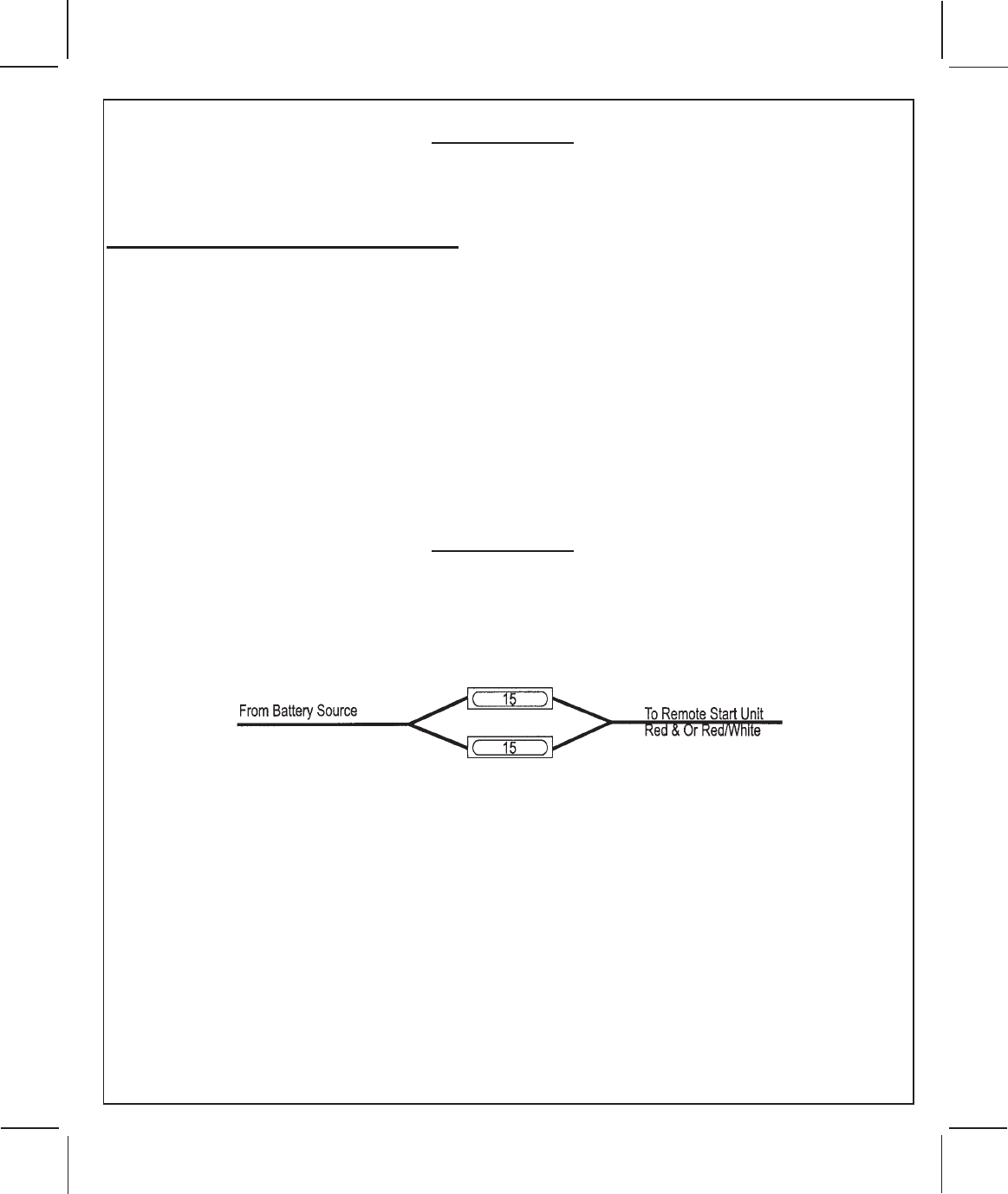
128-8857
6 of 20
IMPORTANT!
DO NOT PLUG THE SIX PIN MAIN POWER HARNESS OR THE MULTI PIN INPUT / OUTPUT HARNESS INTO THE
CONTROL MODULE UNTIL ALL CONNECTIONS TO THE VEHICLE HAVE BEEN MADE. AFTER SELECTING YOUR
TARGET WIRES AS DEFINED BELOW, DISCONNECT THE NEGATIVE BATTERY CABLE FROM THE VEHICLE
BATTERY PRIOR TO MAKING ANY CONNECTIONS.
WIRING THE 6 PIN MAIN POWER HARNESS:
Note:Do not remove the fuse holders from this wire harness. Fuses must be used and
located as close as possible to the power source for adequate protection of the
vehicle.
RED w/ WHITE Trace Wire: +12 Volts Battery 1 Source
Connect this wire to a +12 VDC constant source found at the vehicle's ignition switch using the 30 Amp fuse
and holder provided. This wire provides power for the control circuit as well as the ignition 1 and ignition 2
relays.
RED Wire: +12 Volts Battery 2 Source
Connect this wire to a separate (other than the wire Red or Red/Black is connected to) +12 VDC constant
source found at the vehicle's ignition switch using the 30 Amp fuse and holder provided, but NOT the same
vehicle wire as used by the battery 1 source. Most vehicles have more than one battery source supplying
power to the ignition switch. Separate feed wires must be used for the Red and Red/White wires. If your
vehicle does not have two battery feed wires at the ignition switch, then it is possible to connect both wires
to the vehicle's battery. This wire provides power for the start relay and the accessory relay.
IMPORTANT!
IT IS THE RESPONSIBILITY OF THE INSTALLING TECHNICIAN TO DETERMINE THE LOAD FACTOR OF THE
VEHICLE'S ELECTRICAL CIRCUITS WHEN THE VEHICLE IS RUNNING AND TO ADEQUATELY FUSE THE TWO
POWER WIRES BASED ON THAT LOAD. IF THE VEHICLE, RUNNING UNDER LOAD WITH THE AIR CONDI-
TIONER, HEATER BLOWER MOTOR, AND ACCESSORIES EXCEEDS 24 AMPS CONTINUOUS, WE RECOMMEND
THAT TWO FUSES BE USED IN COMBINATION ON EACH POWER WIRE AS SHOWN BELOW. FOR ADDITIONAL
INFORMATION SEE TECH UPDATE ISSUED 9/30/96.
YELLOW WIRE: Starter Output
Careful consideration for the connection of this wire must be made to prevent the vehicle from starting while
in gear. Understanding the difference between a mechanical and an electrical Neutral Start Switch will allow
you to properly identify the circuit and select the correct installation method. In addition you will realize why the
connection of the safety wire is required for all mechanical switch configurations.
Failure to make this connection properly can result in personal injury and property damage. In all installations it is
the responsibility of the installing technician to test the remote start unit and assure that the vehicle cannot start via
RF control in any gear selection other than park or neutral.
In both mechanical and electrical neutral start switch configurations, the connection of the Yellow wire will be made
to the low current start solenoid wire of the ignition switch harness. This wire will have +12 volts when the ignition
switch is turned to the start (crank) position only. This wire will have 0 volts in all other ignition switch positions.
Note: This wire must be connected to the vehicle side of the starter cut relay (when used). For the electrical
neutral switch configuration, this connection must be made between the starter inhibit relay, (when used)
and the neutral safety switch as shown in the following diagram.
Failure to connect this wire to the ignition switch side of the neutral safety switch can result in personal injury and
property damage.
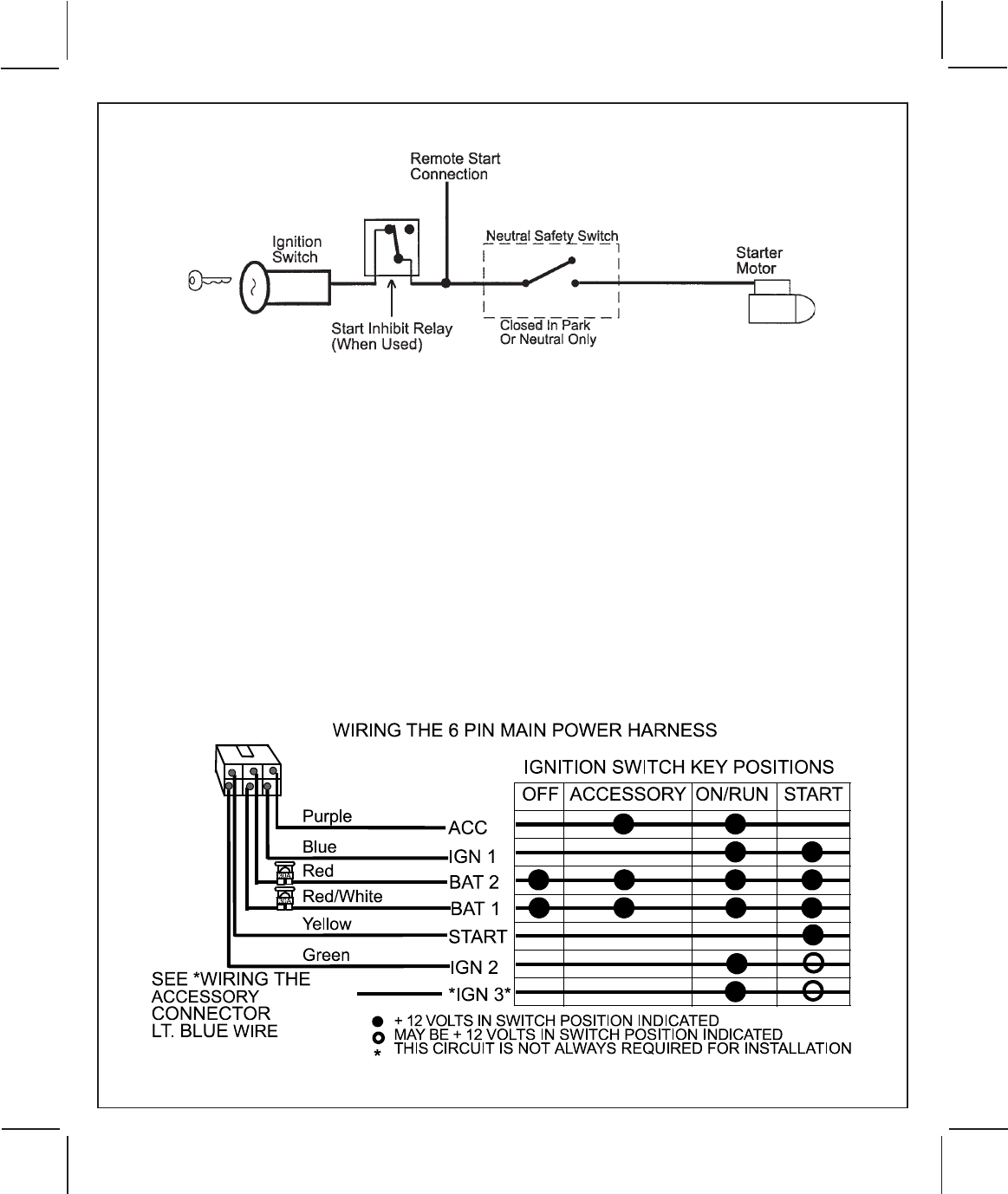
128-8857
7 of 20
SEE NEUTRAL START SAFETY TEST FOR FURTHER DETAILS.
BLUE WIRE: Ignition 1 Output
Connect this wire to the ignition 1 wire from the ignition switch. This wire will show +12 volts when the ignition key
is turned to the to the "ON" or "RUN" and the "START" or CRANK" positions and will have 0 volts when the key is
turned to the "OFF" and "ACCESSORY" positions.
For Diesel Applications, this wire must be connected to the ignition circuit that powers the glow plugs if the vehicle
requires glow plug pre-heating.
GREEN WIRE: Ignition 2 Output
Connect this wire to the ignition 2 wire from the ignition switch. This wire will show +12 volts when the ignition key
is turned to the "ON" or "RUN" position and is some cases the "START" or CRANK" position. This wire will show 0
volts when the key is turned to the "OFF" and "ACCESSORY" positions.
Note: See programming information concerning this wire to allow output during the "START" mode.
VIOLET WIRE: Accessory Output
Connect this wire to the Accessory wire from the ignition switch. This wire will show +12 volts when the ignition
switch is turned to the "ACCESSORY" or "ON" and "RUN" positions and will show 0 volts when the key is turned
to the "OFF" and "START" or "CRANK" positions.
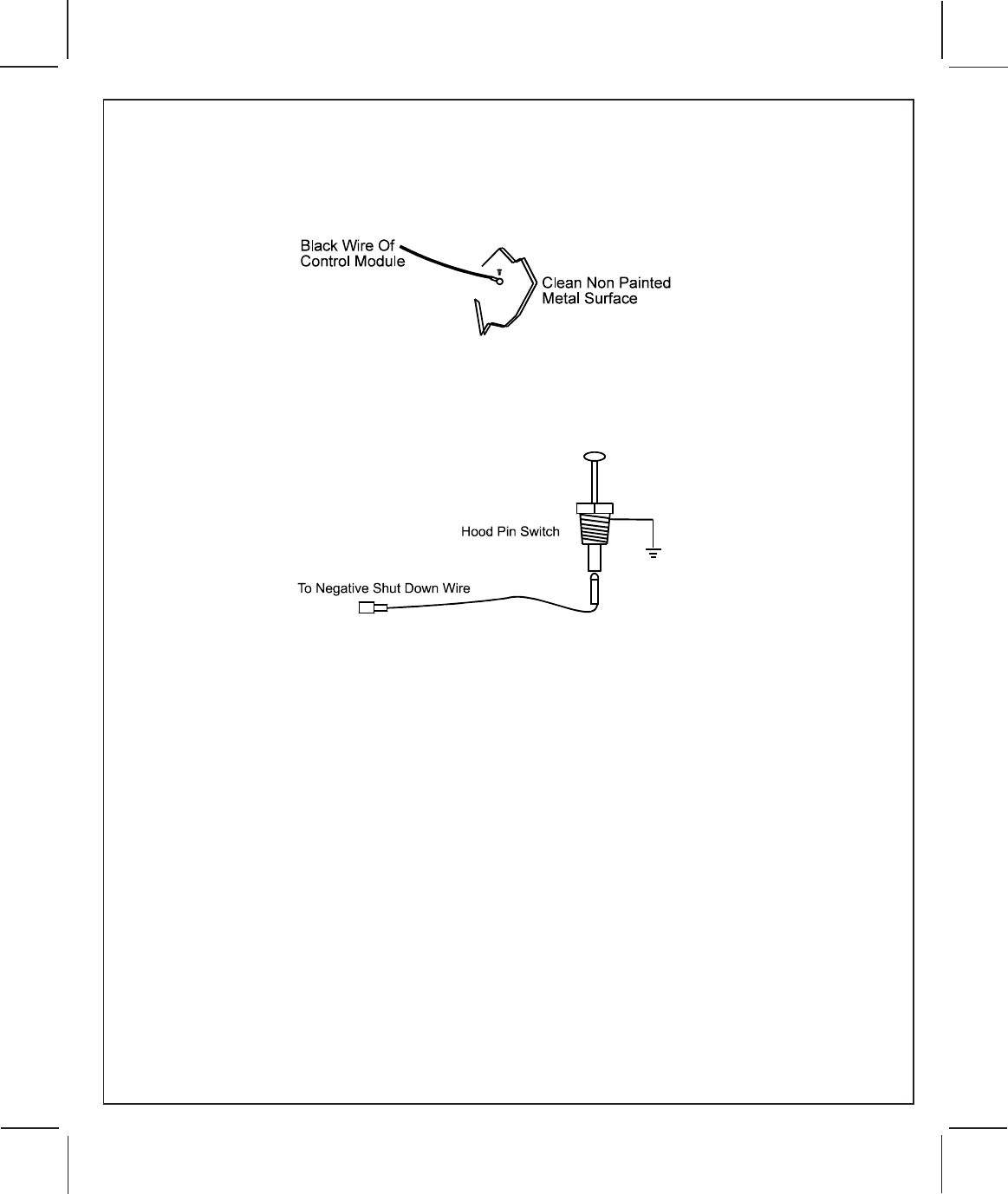
128-8857
8 of 20
WIRING CONNECTIONS: 12 Pin Input / Output Harness
Black Wire: Chassis Ground Source
Connect the Black wire to a known vehicle ground source or to a solid clean metal part of the chassis. Be certain
to remove any paint or grease and secure this wire with a self-tapping screw and ring terminal.
GRAY WIRE: Negative Inhibit Input 1
Connect the GRAY wire to the previously mounted hood pin switch provided. This wire will be routed through the
firewall into the engine compartment. It is necessary to use an existing grommet when passing wires through the
firewall to prevent short circuiting. This is an important safety feature of the System, failure to use this feature can
result in serious injury. Route the wire to the pin switch and connect it using a connector.
GRAY w/ BLACK TRACER WIRE: Negative Inhibit Input 2
Any time the Gray w/ Black tracer wire is grounded, the Remote Starter will stop operating, even if the signal is received
from the transmitter.
If the brake light switch in the vehicle switches ground to the brake light circuit, connect the Gray w/ Black trace wire
to the output of the brake light switch. If the brake light switch in the vehicle switches +12 volts, do not use the Gray
w/ Black wire; see Brown w/ Black tracer wire.
BROWN WIRE: Positive Inhibit Input 1
Any time + 12 volts is applied to the Brown wire, the Remote Starter will stop operating, even if the signal is received
from the transmitter.
If the vehicle has a factory installed hood pin switch and that switch provides +12 volts to an under hood light, the
Brown wire can be connected to the existing pin switch.
BROWN w/ BLACK Tracer Wire: Positive Inhibit Input 2
Any time +12 volts is applied to the Brown w/ Black tracer wire, the Remote Starter will stop operating, even if the
signal is received from the transmitter. If the brake light switch in the vehicle switches +12 volts to the brake light
circuit, connect the Brown w/ Black trace wire to the output of the brake light switch. If the brake light switch in the
vehicle switches ground, do not use the Brown w/ Black wire; see Gray w/ Black tracer wire.
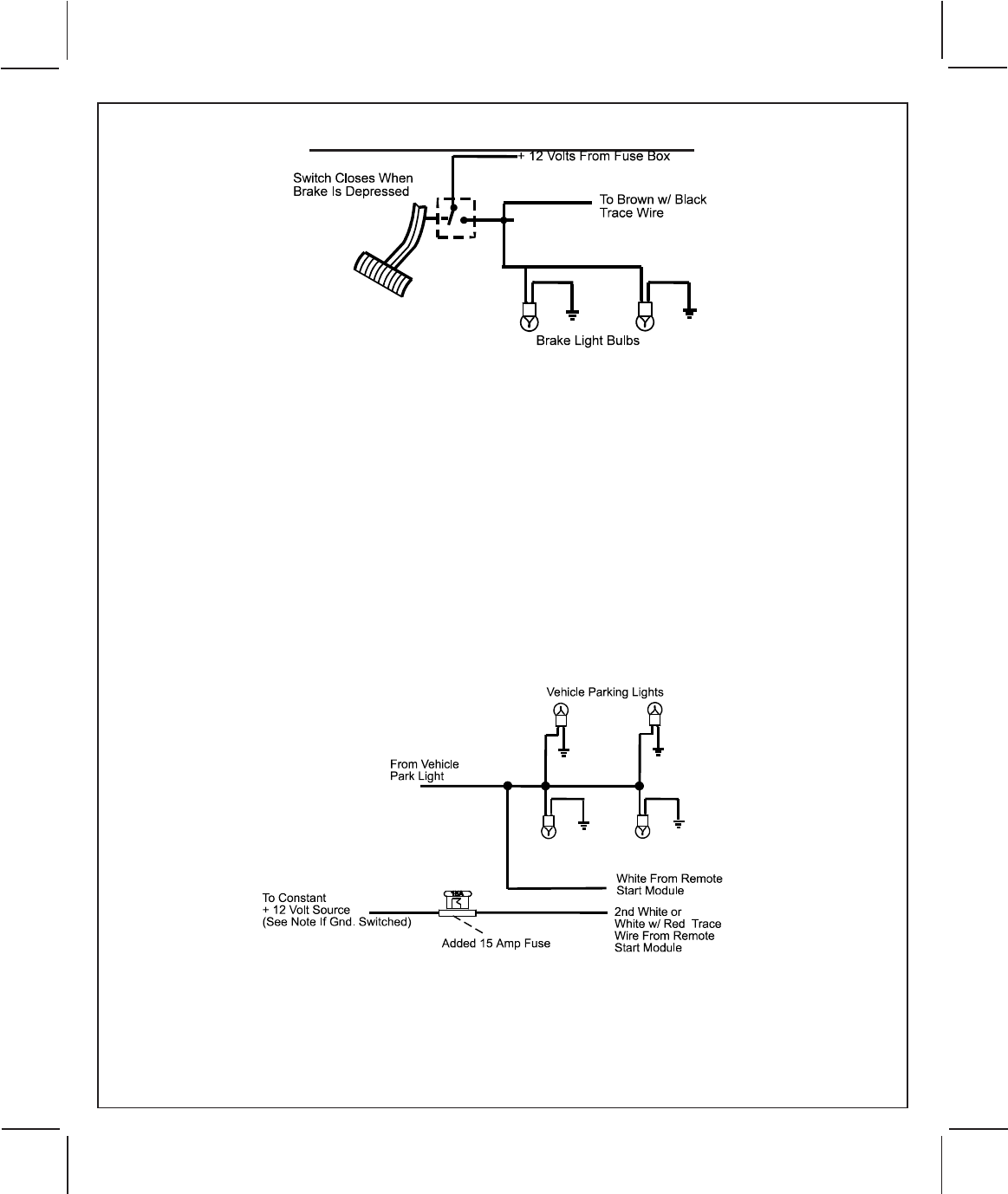
128-8857
9 of 20
Brake Switch Positive Shutdown Detail
YELLOW w/ BLACK Tracer Wire: + 12 Volt Alarm By - Pass Output
Note: You must disconnect the ignition input of the alarm from any other wire that it is presently connected
to in the vehicle.
This wire provides a +12 volt output when the ignition key is turned to the “ON” position, and 0 volts when the ignition
key is “OFF” and when the vehicle is running under the control of the remote starter.
This wire should be connected to the ignition input of the alarm system.
The Yellow w/ Black wire output will allow you to remote start the vehicle while leaving the alarm armed, and to lock/
unlock the doors while running under control of the remote start unit.
(2) WHITE Wires: Parking Light Flasher
These wires are the COMMON and NORMALLY OPEN contacts of the on-board parking lamp relay.
If the vehicle's parking lights are a +12 volt switched system, connect (1) of the White wires to a fused (15 A max.)
+12 volt battery source, and connect the second White wire to the vehicle's parking light wire.
If the vehicle's parking lights are a chassis ground switched system, connect (1) of the White wires to a chassis
ground source, and connect the second White wire to the vehicle's parking light wire.
LIGHT BLUE Wire: Ignition 3 / Shock Disable Output
This wire provides a 300 mA ground output that becomes active 3 seconds before the Remote Start Unit initializes,
and remains grounded while running plus an additional 4 seconds after the Remote Start Unit turns off. In all of
the applications described below, a relay will be required. The Light Blue wire can be used to accommodate the
following situations:
Switch
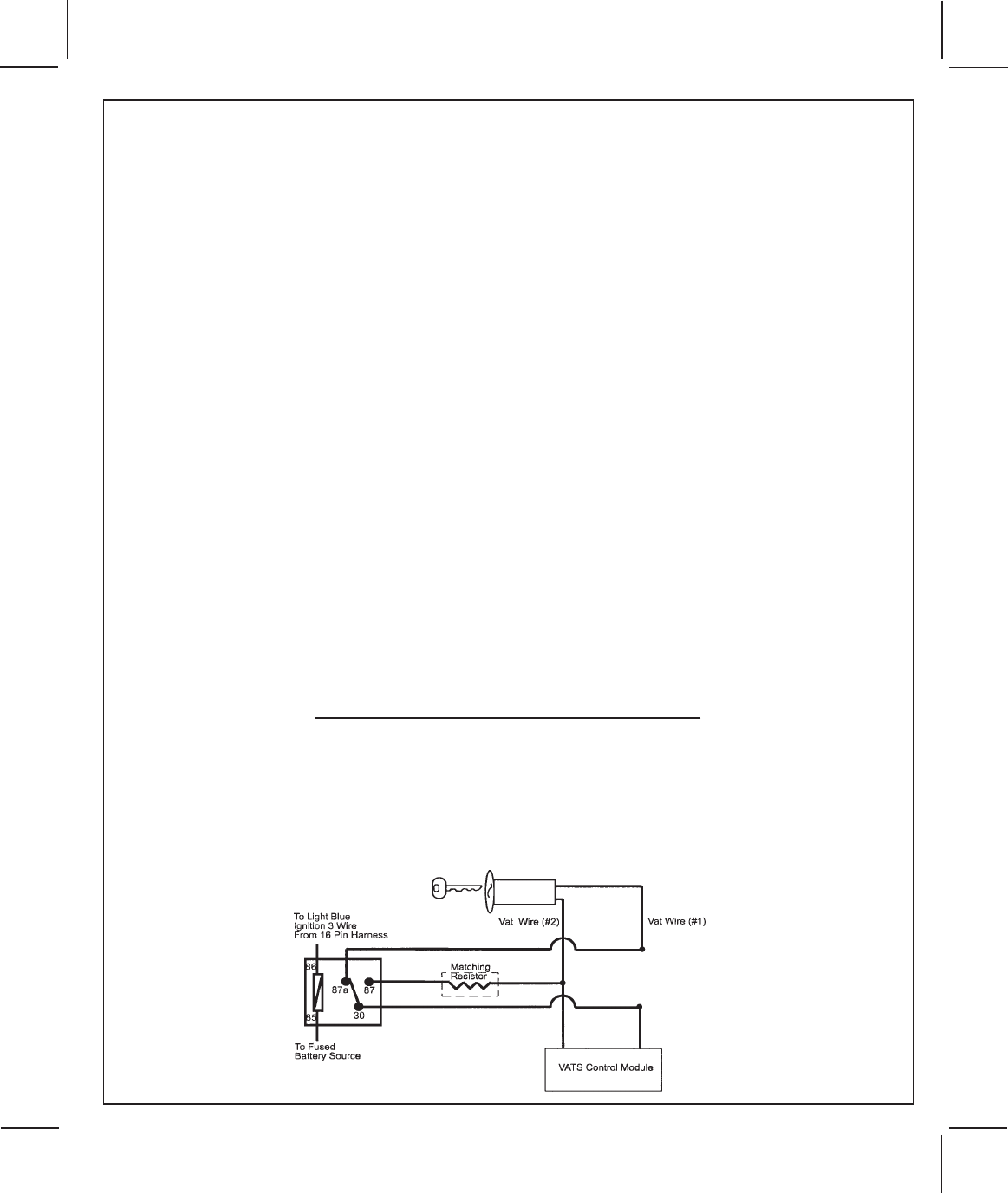
128-8857
10 of 20
A. Shock Sensor By Pass:
If there is Shock Sensor used with an alarm system and it is not shunted during the Remote Start activation
period, then vibration from the running vehicle can cause the alarm to trigger. In this case, connect the Light Blue
Wire to terminal #86 of a external relay. Connect terminal #85 of the relay to a fused +12 volt battery source. Cut
the shock sensor trigger wire and connect one end of the cut wire to terminal #30 and the other end of the cut
wire to terminal #87a. Just before the Remote Start unit is activated, the relay contacts will open, preventing the
shock sensor's operation until the Remote Start unit shuts off.
B. Ignition 3 Output:
Some newer vehicles use a third ignition wire, which is required to start and keep the vehicle's engine running.
If this is the case, connect the Light Blue wire to terminal #86 of an external relay. Connect terminal #30 & #85
to a fused +12 volt battery source rated for a minimum of 25 Amp. Connect terminal #87 to the third ignition wire
in the vehicle.
C. GM VATS Key Override:
If the vehicle has the General Motors VATS system installed, you will need to bypass the system while the vehicle
is operating under the control of the Remote Start Unit. To Do This;
1. Measure the resistance of the resistor pellet on the ignition key then select a resistor within 5% of the key's
value from the resistor pack supplied.
2. Locate the pair of VATS wires in the vehicle, usually a pair of thin gauge wires running from the ignition switch
to the VATS control module.
NOTE: These wires are typically White w/ Black trace and Violet w/ Yellow trace, however in later model Cadillacs,
they are run through an orange sleeve, and are either both Black, both Yellow, or both White wires. Consult
the factory service manual for additional information.
3. Connect the Light Blue Wire from the Remote Start Unit to terminal #86 of an external relay. Connect terminal
#85 of the relay to a fused +12 volt battery source.
4. Cut (#1) wire (as shown), and connect the ignition switch side of the cut wire to terminal #87a of the relay.
Connect the other side of the (#1) wire to terminal #30.
5. Connect the previously selected resistor from terminal #87 to the second (#2) wire (as shown).
Note: The above information and following diagram is for the GM VATS system only. For GM PASS LOCK System
you will require the Audiovox AS-PASS II Module.
General Motors VATS By-Pass Diagram
GREEN/ORANGE Wire: Tach Sensor Input
This wire will continually monitor the engine tach rate while the unit is under power of the Remote Start module.
This wire will be routed to the vehicle ECM tach input or through the firewall into the engine compartment and
connect to the negative side of the ignition coil. This Remote Start unit learns the tach rate of the vehicle and in most
cases will operate properly from one multi coil pack regardless of the number of cylinders. If the vehicle has a
single coil unit for each cylinder, it may be necessary to connect this wire to more than one cylinder for proper tach
reference. See the multi coil wiring detail shown later in this manual for additional information.
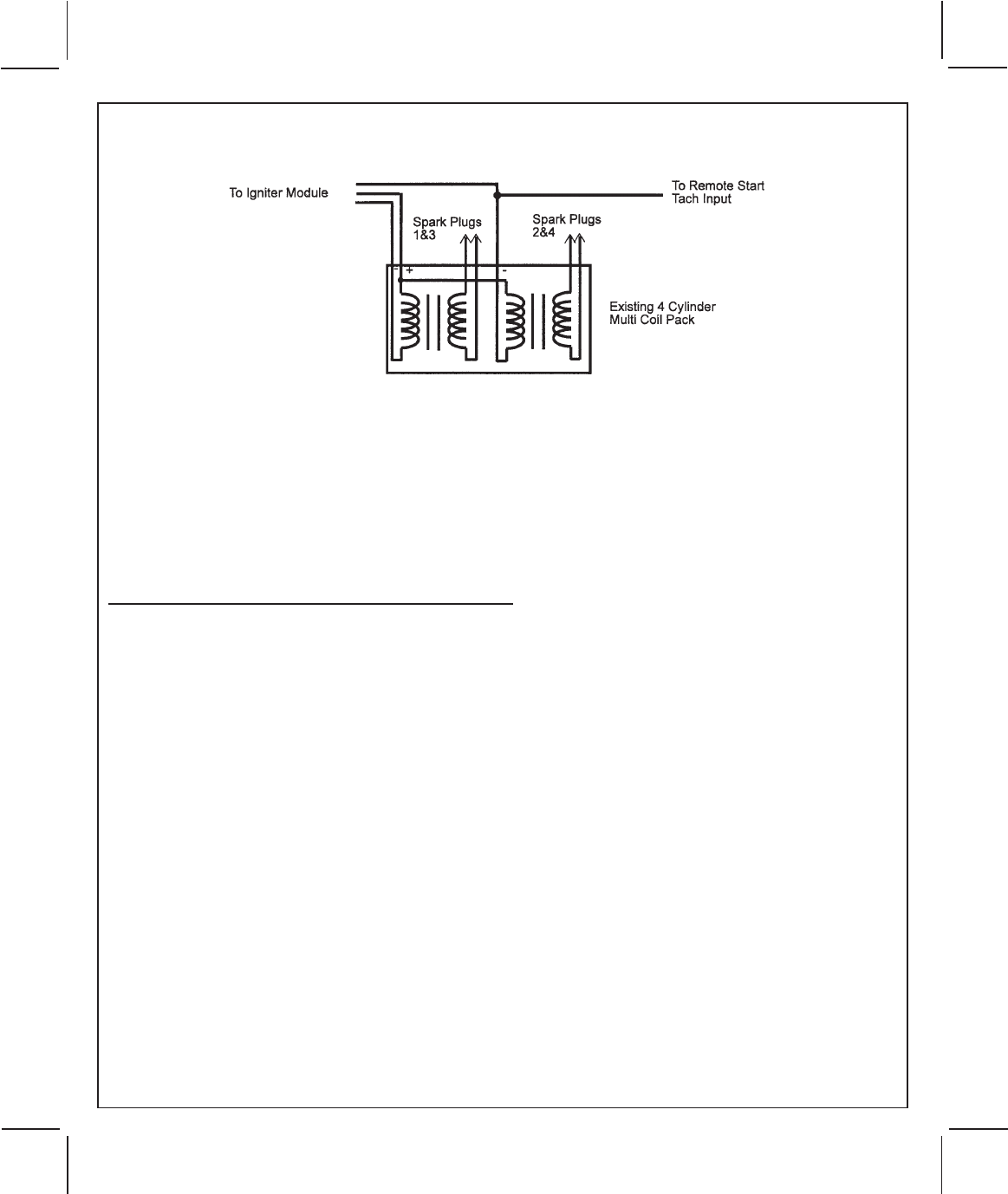
128-8857
11 of 20
Note: For Hybrid mode, Bank 3 feature selection 5, this connection is not used, the unit will start the vehicle
and run the allotted time based on feature selection and crank duration.
Tachometer Input Wiring Detail
Green/Yellow Wire: Diesel Wait To Start Input
The Green/Yellow wire will connect to a diesel vehicle's glow plug wire. When the unit receives a start command,
this wire must go to +12 then to ground to allow the crank sequence to begin. When ignition #1 is activated by the
remote start unit, the glow plug circuit gets energized (+12 volts). When the glow plug circuit of the vehicle drops the
+12 volts, which effectively grounds the wait to start input, then 500 mS later the starter will engage. This wire can
also be connected to the Glow Plug Bulb wire in the vehicle if this bulb wire gets +12 volts when the ignition comes
on and drops low when the glow plug circuits temperature is reached. Be sure to fuse the wire with a 1 Amp Fuse
when connecting to a high current circuit such as a factory glow plug wire. The fuse should be installed as close to
the high current wire as possible. If you are installing this unit in a Gasoline vehicle, this wire is not used.
Note: If the Glow Plug sense wire, Green/Yellow is connected, this wire will have priority over the setting of feature
Bank 3 Feature #11.
WIRING THE 4 PIN AUXILIARY OUTPUT HARNESS
The auxiliary 4 pin connector provides low current outputs to control various functions in the vehicle during
different stages of the Remote Start unit's operation. Understanding these outputs and the time in which
they occur will allow you to determine if they are needed for the particular vehicle you are working on as well
as how to use them.
Black w Blue Trace Wire: Pulsed Ground Output Before Start
The Black w/ Blue Trace wire will provide a 1 second 300 mA pulsed ground output 1.5 second before the
remote start unit activates as well as when the transmitter is used to disarm the system. Typical use for this
output would be to disarm a factory theft deterrent system to prevent false triggering of the factory alarm
when the remote start unit engages or when the transmitter is used to unlock the doors.
Black w/ Light Green Trace Wire: Pulsed Ground Output After Start
The Black w/ Light Green Trace wire will provide a 1 second 300 mA pulsed ground output after the vehicle
is started under control of the remote start unit. Typically this wire will be used to re-lock the vehicle doors
if the doors unlock automatically when the factory anti-theft system is disarmed.
Black w/ Red Trace Wire: Pulsed Ground Output After Shutdown
The Black w/ Red Trace wire will provide a 1 second 300 mA pulsed ground output after the remote start unit
shuts down. This output will occur regardless of whether the circuit times out or is manually terminated.
Typically this output will be used to re-lock the vehicle doors if the doors unlock automatically when the
ignition circuit transitions to off.
Black w/ Yellow Trace Wire: Ground Output During Start (Crank)
The Black w/ Yellow Trace wire will provide a 300 mA ground output while the starter output of the remote
start unit is active. This output can be used to activate the Crank Low/Bulb Test wire found in some GM
vehicles. This wire is also referred to as the ECM wake up wire in some Chrysler vehicles.
Note: The outputs above are low current outputs and must be used with a relay if the circuit's requirement
is more than 300 mA.

128-8857
12 of 20
6 Wires Of The Antenna/Transceiver PB/LED Connector:
Plug the previously routed antenna connector from the antenna transceiver assembley into the mating con-
nectors of the control module. These connectors supply 12 volts, ground, RF data input & output, LED
cathode, and Valet Enable to and from the antenna transceiver and the remote start module. Be certain these
connectors are firmly seated and making good contact to the control unit.
2 Pin Transponder Control Output: (Yellow Connector)
This output is intended to allow the control of a transponder bypass interface module or transponder
bypass relay. The system also allows software selections to control the way in which this output oper-
ates. See remote start feature # 10 for setting this output.
When the unit is selected for output during the start sequence, this output will be active at the same time
Ign. 3 becomes active, and will remain active until the vehicle has started. This will be used for one time
read transponder circuits.
When the unit is selected for transponder on, this output will become active at the same time ign. 3
becomes active, and will remain active all the time the unit is operational under the control of the remote
start. When the unit is selected for continuous and the vehicle is started via the Remote Start, this output
will become active at the same time ign. 3 becomes active and will remain active until the ignition in the
vehicle goes low. This will allow the unit to be used for continuous read transponders circuits.
Programming Tach Rate:
Note: All applications require that tach be programmed.
The unit will not operate unless tach is programmed. If an attempt is made to start the vehicle via the remote start
without first programming tach, the unit will flash the parking lights 7 times, indicating tach has not been learned and
stored. If the tach rate is not properly programmed to the specific vehicle, the unit may not realize that the vehicle is
running in certain instances and could re-engage the starter motor.
The Remote Car Starter will learn the tach rate of most vehicles single ignition coils, multiple coil packs, and/or single
injector. To learn tach:
1. Turn the ignition key to the ON position.
2. Press and release the receiver's program push-button switch 3 times.
3. Immediately turn the ignition key OFF.
4. Hold the program push-button switch ON, then start the vehicle using the ignition key.
5. When the unit senses the tach signal, the parking lights will begin to flash.
6. Release the program push-button switch. The parking lights will turn on for 3 seconds to indicate that the tach
signal is stored and the unit is now out of the program mode.
Diagnostics:
1. Be sure that programmable feature number #9 is set to the "Diagnostics On" mode.
2. Press and hold the program push-button switch on, then turn the ignition key to the "ON" position.
3. The lights will flash and the number of flashes will indicate the reason for shutdown on the last remote start attempt.
The indications are as follows:
1 Flash 5, 10, 15, or 20, minute run timer expired.
2 Flashes Low or No tach signal received.
3 Flashes Positive input shut down.
4 Flashes Control switch was moved to "Off" position.
5 Flashes RF Shutdown command received.
6 Flashes High RPM signal over speed shut down.
7 Flashes Tach has NOT learned.
8 Flashes Negative input shut down
Multi Coil Pack Adapter: (Optional)
The multi coil pack adapter is designed for use with vehicles that do not respond to single coil tach program-
ming. Although the tach resolution of this circuit is designed to interface directly with most vehicles, there
may be an occasion where the following circuit may be required. Construct the adaptor as shown below:
To use the adapter, the Green/Black wires must connect to the negative side of the ignition coil(s).
1. For vehicles utilizing independent coils per cylinder, connect the three Green/Black leads to alternate coils. To
achieve optimum performance the coil signals must be evenly distributed. This is accomplished by first map-
ping out the firing order of the engine in groups of as indicated below. Draw a circle around any of the columns.
The Green/Black wires should be connected to the negative (-) terminal of the respective cylinder number which
appears in any of the circles.
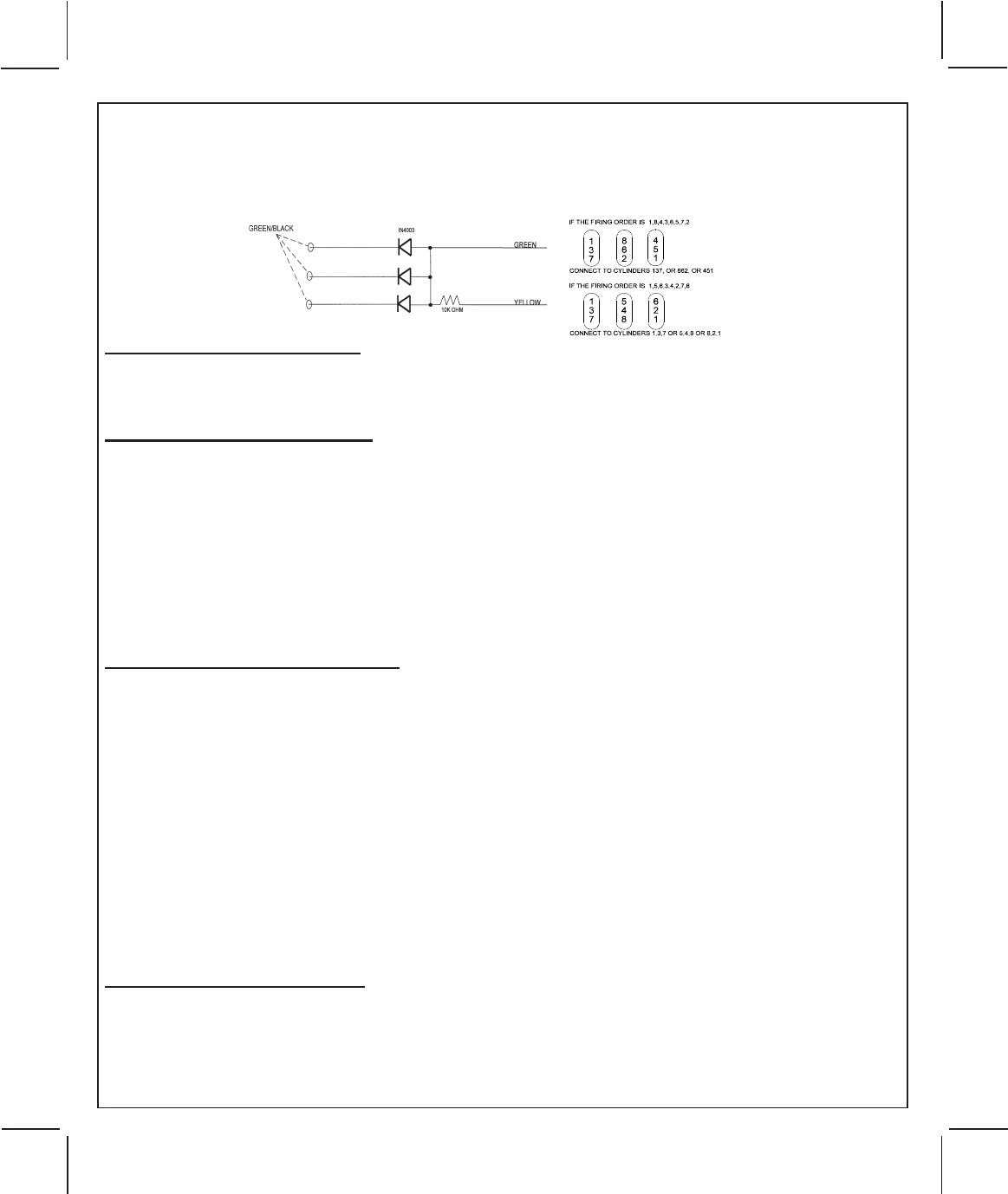
128-8857
13 of 20
2. For vehicles utilizing 2 cylinder firing per coil pack, connect Green/Black to the tach side of each coil pack. For 8
cylinder, four coil systems, connect to any of the three coils.
3. Connect the Yellow wire to a +12 volt ignition 1 source. This wire will have +12 volts with the ignition in the on and
start position and have 0 volts with the ignition in the off position.
4. Connect the Green wire to the (Green) or (Orange/Green) tach input of the Audiovox remote start unit.
TESTING YOUR INSTALLATION:
WARNING!! The following procedure must be performed after the installation of an Audiovox Remote Start
Device. It is the responsibility of the installing technician to complete these tests. Failure to test the unit in the
following manner may result in personal injury, property damage, or both.
HOOD PIN SAFETY SHUT DOWN:
The intention of the hood pin safety shut down is to prevent the Remote Start unit from being activated while a
mechanic or vehicle owner is performing normal routine vehicle maintenance.
To test the integrity of this circuit:
1. With the driver's window in the down position, start the vehicle using the RF transmitter.
2. Reach inside the car and pull the hood release.
3. Raise the hood and confirm that the remote start unit shuts down.
If the unit fails this test, recheck your pin switch connection to the Gray/Black wire of the Audiovox Remote Start Unit.
WARNING!!
DO NOT RELEASE THIS VEHICLE TO THE CONSUMER UNTIL YOU CONFIRM THE
OPERATION OF THE HOOD PIN SAFETY SHUT DOWN FEATURE.
MANUAL SHUT DOWN / ENABLE CIRCUIT:
The intent of the manual shut down / enable circuit is to allow the vehicle operator to prevent operation of the
Remote Start Unit regardless of the RF transmitter operation.
1. With the system disarmed/unlocked, and the ignition switch off Press and Hold the pushbutton switch
located on the receiver unit on.
2. Turn the ignition switch on, off, on, off, on, off.
3. The LED begins to flash two short flashes followed by one long flashes and continues this pattern until
returned to normal mode of operation.
This puts the unit into the R/S Override mode indicating that the remote start is in the service mode and will not
start from RF or any other input Posse or otherwise.
To Exit R/S Override Mode
1. With the system disarmed, Press and Hold the pushbutton switch located on the receiver unit on.
2. Turn the ignition switch on, off, on, off, on, off.
3. The LED turns off indicating that the R/S unit is fully functional one again.
WARNING!!
DO NOT RELEASE THIS VEHICLE TO THE CONSUMER UNTIL YOU CONFIRM THE
OPERATION OF THE MANUAL SHUT DOWN / ENABLE FEATURE.
NEUTRAL START SAFETY TEST:
The intent of the neutral start switch is to prevent the vehicle from starting while the gear selector is in any position
other than Park, or Neutral. When installing a Remote Start Device, it is imperative that the Yellow Starter wire be
connected to the ignition switch side of the Neutral Start Switch. Consideration for the placement of a starter inhibit
relay is important as well, and should be connected to the ignition switch side of the Yellow Start Wire.

128-8857
14 of 20
To test the integrity of the Neutral Start Safety Circuit:
1. Set the vehicle parking brake.
2. Block the drive wheels to prevent vehicle movement.
3. Temporarily disconnect the Brown/Black positive shut down wire from the vehicle's brake switch.
4. Sitting in the vehicle, start the engine using the vehicle's ignition key.
5. Step on the brake pedal and shift the gear selector into reverse.
6. Allow the transmission to shift. When you feel the engine pull, do not move the gear selector just turn the ignition
switch off. DO NOT attempt to remove the key.
7. Keeping the brake pedal depressed, activate the RF transmitter in an attempt to start the vehicle. The car should
not start.
8. Repeat the above test this time move the gear selector to the drive position. If the unit attempts to start, failing this
test, recheck your Yellow Wire's connection. This wire must be connected to the ignition switch side of the Neutral
Start Switch. If the vehicle you are working on does not have an Electrical Neutral Safety Switch, it will be
necessary to reconfigure the Remote Starts Wiring to accommodate this vehicle. The information concerning the
Mechanical Neutral Safety Switch provided below will help you to determine if the vehicle you are working on has
this type of safety switch and will provide alternate wiring methods to accommodate this situation.
WARNING!!
REMEMBER TO RECONNECT THE BROWN/BLACK WIRE TEMPORARILY
DISCONNECTED IN STEP 3.
DO NOT RELEASE THIS VEHICLE TO THE CONSUMER UNTIL YOU CONFIRM THE OPERATION OF
THE NEUTRAL SAFETY START FEATURE.
MECHANICAL NEUTRAL SAFETY SWITCH CONSIDERATIONS:
Mechanical neutral safety switch configurations differ slightly in that they do not offer the same level of safety when installing a
remote start device. Often when the ignition switch is turned off while the gear selector is in any position other than park or neutral,
the mechanical function will not allow the key to be turned to the start position or be removed from the ignition cylinder. This
configuration prevents mechanical operation while the vehicle is in gear but offers no consideration for electrical operation.
Because of this potential problem, this installation requires the additional connection of a safety wire from the remote start device
to the vehicle Park/Neutral ECM Input or the vehicle key in sensor. This connection will prevent remote start operation if the key is
left in the ignition switch regardless of the gear selector position.
KEY IN SENSOR CIRCUITS:
If the vehicle you are working on does not have or you cannot locate the ECM reference wire, there are two alternatives
available. Although not preferred, the vehicle Key In Sensor may be reconfigured to allow a margin of safety and will
prevent the vehicle with a Mechanical Neutral Start Switch from starting in gear.
AUDIOVOX ADVISES THAT YOU MAINTAIN THE FACTORY CIRCUIT WHENEVER POSSIBLE. The following two
circuits may be used only if the above circuit is not available.
NOTE: When completing an installation using either of the following key in sensor circuits, if the operator inserts the
ignition key while the vehicle is running under the control of the Remote Start, the vehicle will shut down. This
must be explained to the operator as it is in contrast to the normal operation of a vehicle utilizing an electrical
neutral start switch and is inconsistent with the operator's manual.
Additional information concerning Key In Sensor methods 1 & 2 are listed below and should be reviewed before
considering either alternative.
Method 1 will allow the safety required for the remote start unit and prevent the vehicle from starting while in any gear
other than Park or Neutral while the key is in the ignition cylinder. However, if the key is left in the ignition switch and
the door is left opened, the added relay will be energized causing a 150mA drain on the battery.
Method 2 will allow the safety required for the remote start unit and prevent the vehicle from starting while in any gear
other than Park or Neutral while the key is in the ignition cylinder. However, the original factory key in chime module
will not alert the owner that the key has been left in the ignition switch. In addition, this may also effect other warning
tones such as the light on reminder.
These situations should be carefully considered before altering the vehicle's wiring and must be fully explained to
the consumer.
Circuits may be used only if the above circuit is not available.
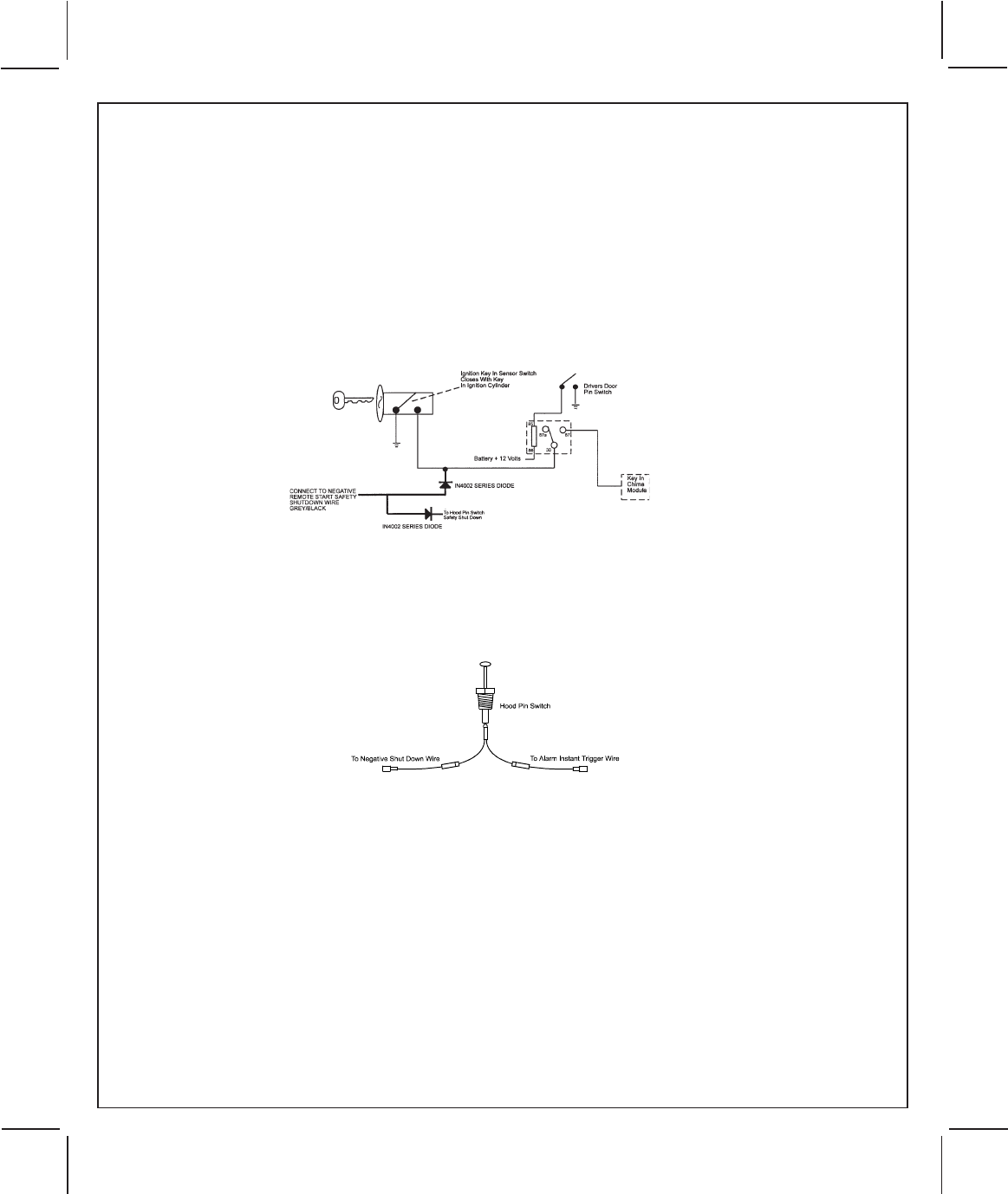
128-8857
15 of 20
METHOD 1
To connect to the key in sensor as shown in method 1:
A. Locate the control wire that connects the drivers door pin switch to the key in sensor switch.
B. Cut this wire and connect the ignition cylinder side to chassis ground.
C. Locate the key in sensor switch wire that connects the chime module to the ignition cylinder .
D. Cut this wire and connect the ignition cylinder side to terminal #30 of a P&B VF45F11 or equivalent relay.
E. Connect the cathode (striped) side of a 4002 series diode to this same wire, and connect the (non striped) side
to the negative shut down safety wire (Gray / Black) of the Audiovox Remote Start Unit.
F. Connect terminal #86 of the relay to a fused +12 volt constant battery source.
G. Connect terminal #87 of the relay to the Chime Module side of the previously cut wire in step D.
H. Connect terminal #85 of the relay to the Drivers Door side of the pin switch wire previously cut in step B.
NOTE: A second 4002 series diode may be required to maintain the integrity of the hood open, shut down circuit. If
this is the case, it must be installed as shown in the diagram above. The anode (Non Striped) side must be
connected to the Gray/Black wire of the Remote Start Unit. The cathode (Striped) side must be connected to
the hood pin switch. If the hood pin switch is also used for an alarm trigger input, be certain to use the
dual diode setup as shown earlier in this manual under the title Gray Negative Inhibit.
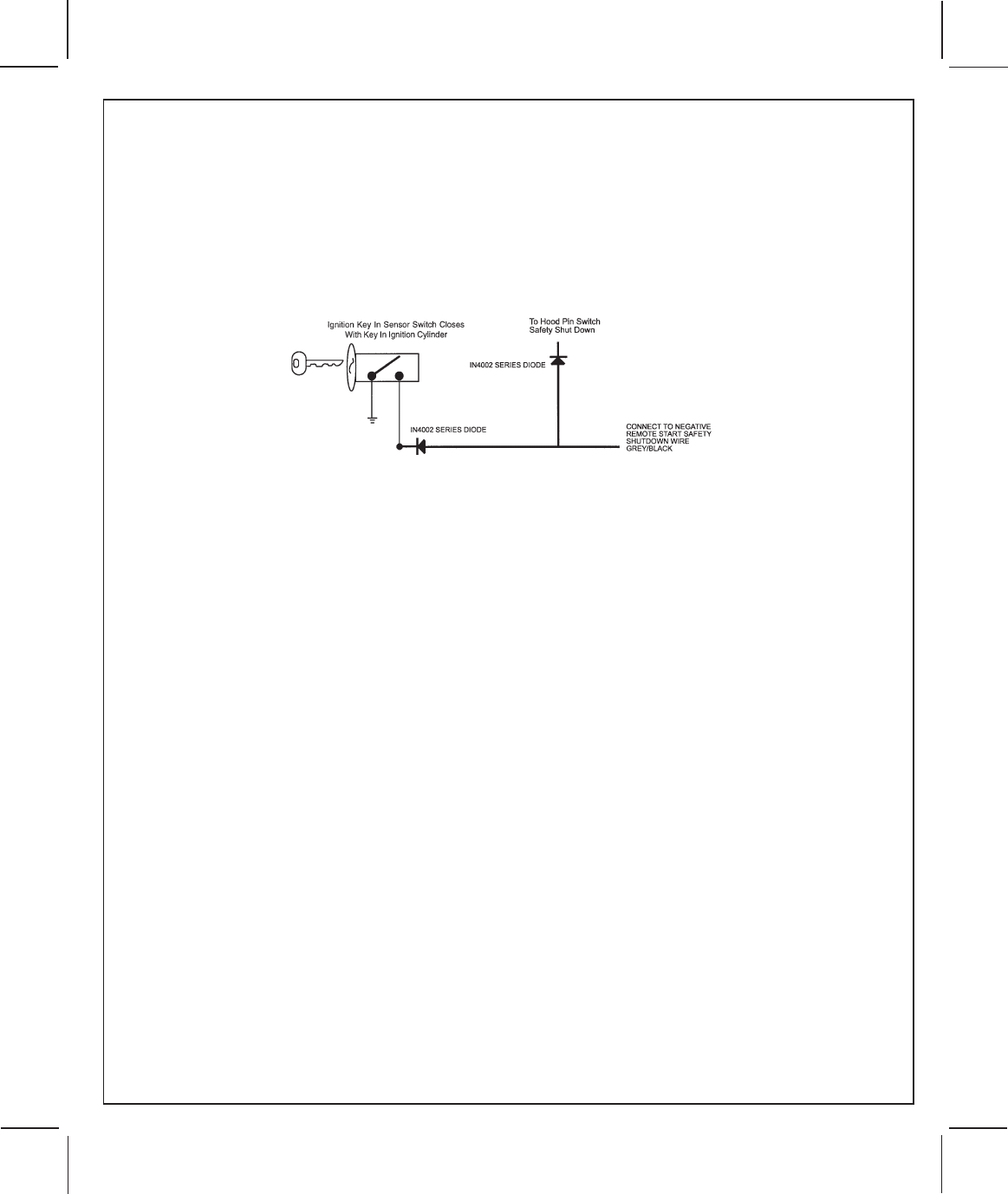
128-8857
16 of 20
METHOD 2
To connect to the key in sensor circuit as shown for method 2:
A. Locate the control wire that connects the drivers door pin switch to the key in sensor switch.
B. Cut this wire and connect the ignition cylinder side to chassis ground.
C. Locate the key in sensor switch wire that connects the chime module to the ignition cylinder .
D. Cut this wire and connect the ignition cylinder side to the Remote Start Negative Safety Shut down Wire Gray/
Black, using a 4002 series diode as shown above.
NOTE: A second 4002 series diode may be required to maintain the integrity of the hood open, shut down circuit.
If this is the case, it must be installed as shown in the diagram above. The anode (Non Striped) side must
be connected to the Gray/Black wire of the Remote Start Unit. The cathode (Striped) side must be con-
nected to the hood pin switch. If the hood pin switch is also used for an alarm trigger input, be certain
to use the dual diode setup as shown earlier in this manual under the title Gray Negative Inhibit.
AFTER THE CONNECTION OF THE NEUTRAL START SAFETY WIRE AS INDICATED IN ANY OF THE PREVIOUS
ALTERNATE CONFIGURATIONS, THIS CIRCUIT MUST BE TESTED FOR OPERATION.
Retest by following the steps outlined in the NEUTRAL START SAFETY TEST shown in this manual.
This device complies with FCC Rules Part 15 Operation is subject to the following two conditions
(1) This device may not cause harmful interference and
(2) This device must accept any interference that may be received, including interference that may cause
undesired operation.
NOTE: The manufacturer is not responsible for any radio or TV interference caused by unauthorized
modifications to this equipment. Such modifications could void the user’s authority to operate the
equipment.

128-8857
17 of 20
4 Pin Upgrade Telematic Module:
Red = + 5 Volts
Black = Ground
White = Data TXYellow = Data RX
If used, connect the 4 pin harness from the Telematic one way module kit to the mating port on the
controlling circuit. NOTE: If using the TWO WAY Telematic module, only Ground, TX, and RX are used on
this port, the + 12 volt supply for the two way module must be sourced separately or the unit will not
operate.
4 Pin Upgrade Data Bus/Flash Logic Module:
If you are using an Audiovox Flash Logic module, it can be connected directly to the Alarm/Remote Start's
control module. Using the Blue 4 pin blue, red, black, & white harness and connect to the mating connector
on the Alarm/Remote Start control module. Wire the Flash Logic/Data Bus module to the vehicle as
prescribed in it's installation guide.

128-8857
18 of 20
COMPLETING THE INSTALLATION:
After you have confirmed the operation of the Audiovox Remote Start unit and tested all the safety features of the
system:
1. Mount the control module up and behind the dash securing it in place with cable ties or screws. Be certain that
the chosen mounting location will not inhibit any of the controls of the vehicle.
2. Securely harness and tie all wiring up and away from all hot and moving parts that they may come in contact with
under the dash board or in the engine compartment areas.
CAUTION: Particularly avoid the area around the steering shaft and column, as wires can wrap around
these mechanisms and impair the safe operation of the vehicle.
3. Apply the Caution Labels supplied with this kit to a conspicuous area in the engine compartment. Make sure to
clean the surface before affixing the label.
4. Check the vehicle's wipers, lights, horn, etc.... to insure proper operation.
5. Replace all panels that were removed during installation, and retest the system.
6. Explain all activated features and safety systems associated with the Remote Start Unit installed. Also point out
the location of the Push-Button LED Override/Valet switch to the customer and explain it's operation.
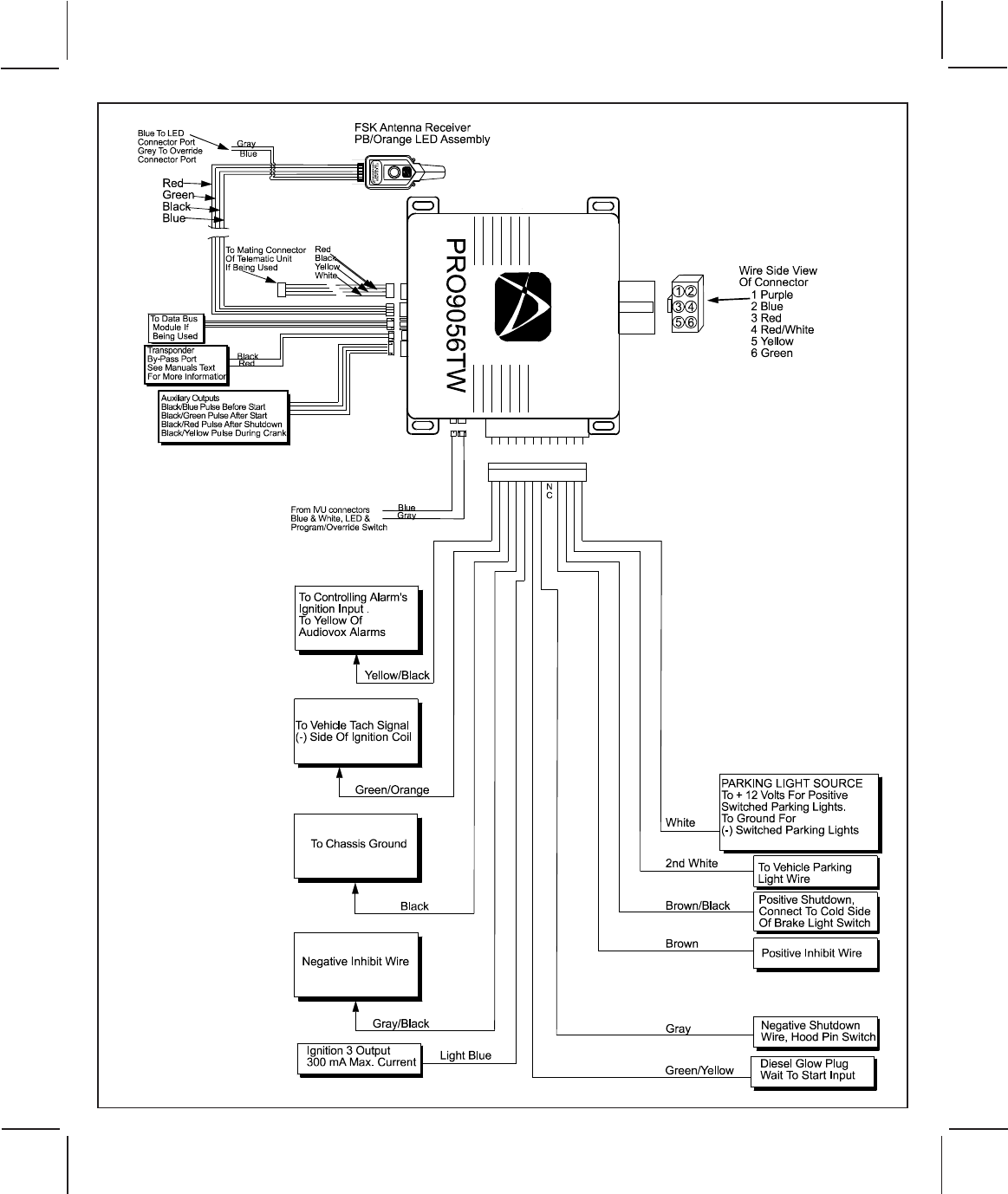
128-8857
19 of 20

128-8857
20 of 20
© 2010 Audiovox Electronics Corp., Hauppauge, NY 11788 128-8857
WWW
.audiovox.com
For Customer Service
Visit Our Website At
Product Information, Photos,
FAQ’s Owner’s Manuals